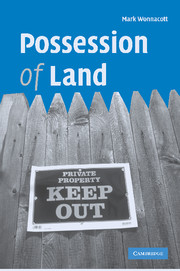Book contents
- Frontmatter
- Contents
- Preface and acknowledgments
- Table of cases
- Table of statutes
- Table of statutory instruments
- 1 Meaning of possession
- 2 Protection of possession
- 3 Possession, title and freehold land
- 4 Leases and licences
- 5 Mortgages and charges
- 6 Equity and trusts
- 7 Birth and death, dissolution and insolvency
- 8 Adverse possession and prescription
- 9 Possession judgments
- 10 Summary and conclusions
- Index
2 - Protection of possession
Published online by Cambridge University Press: 13 August 2009
- Frontmatter
- Contents
- Preface and acknowledgments
- Table of cases
- Table of statutes
- Table of statutory instruments
- 1 Meaning of possession
- 2 Protection of possession
- 3 Possession, title and freehold land
- 4 Leases and licences
- 5 Mortgages and charges
- 6 Equity and trusts
- 7 Birth and death, dissolution and insolvency
- 8 Adverse possession and prescription
- 9 Possession judgments
- 10 Summary and conclusions
- Index
Summary
Introduction
The previous chapter distinguished between the various meanings of the word ‘possession’, and defined the key concept of possession of an estate. This chapter explores the importance of that concept to legal disputes about the use or enjoyment of land.
The possessory actions
The common law protects the use and enjoyment of land, and the right to use and enjoy land, by three possessory actions.
The first is the action for recovery of land. This is the action by which a person who has a right to possess a freehold, or a lease, or a profit à prendre, may vindicate that right, by using the process of the court to oust the person who is in fact in possession of it, and to require that person to pay compensation (called mesne profits) for the wrongful use of it in the meantime.
The second is the action of trespass to land. By this action, a person who is in fact in possession of a freehold, a lease or a profit à prendre, or who has a right to possess it, may obtain compensation for wrongful physical intrusions which fall short of a dispossession.
The third is the action of nuisance. This is the action by which a person who is in possession of a freehold, a lease or a profit á prendre, or who has a right to possess it (or, indeed, who has a right to any legal interest in the land, except an advowson or franchise) may obtain compensation for wrongful interference with its use or enjoyment which does not involve a physical intrusion.
- Type
- Chapter
- Information
- Possession of Land , pp. 19 - 34Publisher: Cambridge University PressPrint publication year: 2006



